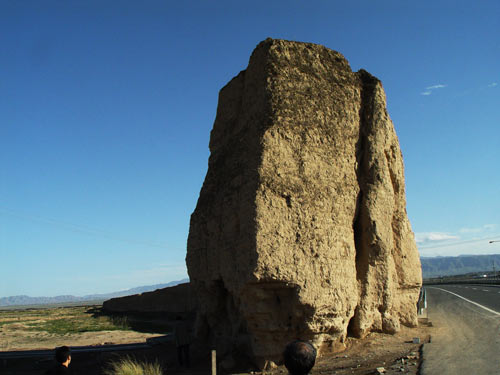Palette of life
Updated: 2013-11-07 00:53
By Li Yang (China Daily)
|
|||||||||||
 |
|
The sections of the Great Walls built in the Han and Ming dynasties is one of two major attractions in Zhangye, Gansu province. Qi Ta / For China Daily |
Zhangye has a rich historical legacy. North of the city, thousands of ancient tombs are covered by potato fields or stretches of sand. Thousands more have already been robbed or destroyed.
It is said one 50-km section of road in Zhangye connecting Gansu and the Xinjiang Uygur autonomous region was built with the remains of ancient tombs, which were looted by the local warlord Ma Bufang to pay for his soldiers' provisions during China's civil war between 1945 and 1949.
Dafo Temple in Zhangye's urban area is famous for a clay sleeping Sakyamuni sculpture 35 meters long and 8 meters wide.
The temple, built in the Western Xia regime (1038-1277), gradually became the largest Buddhist center in the Hexi Corridor after several rounds of rebuilding. Kublai Khan, grandson of Genghis Khan and emperor of the Yuan Dynasty (1271-1368), was said to be born in the temple in 1215.
The exchange of civilizations on the Silk Road brought a treasure trove of ancient Buddhist books to the temple, most of which were destroyed during the "cultural revolution" (1966-76), including those hidden in the abdomen of the big Buddha statue.
The valuable Buddhist texts exhibited in the temple today, dating back to the Tang Dynasty (AD 618-907), were protected in the scripture library by a nun named Benjue. She secretly hid 12 boxes of valuable books in her tiny room in 1955 until her death in a fire in 1975.
To the south of Zhangye, out of the Danxia range, lies the Shandan army-horse-breeding farm of 2,200 square km. It's one of the largest of its kind in the world. The farm was built in the Han Dynasty to defend against the invading nomadic tribes and prospered until the late Qing Dynasty (1644-1911). It is now operated by a State-owned enterprise of animal husbandry for agricultural production and tourism.
North of Zhangye, two parallel Great Walls built with soil run 10 to 80 meters apart for almost 100 km at the foot of the Qilian Mountains along the Hexi Corridor. They represent one of the best-preserved Great Wall sections in China.
The outer wall was built in 111 BC in the Han Dynasty, while the inner wall was built in 1572 in the Ming Dynasty. They look magnificent against the bigger backdrop of the snow-capped Qilian Mountains.
The local government protects the walls with barbed wire to prevent shepherds from digging dwelling caves in the wall or farmers from digging into the wall for soil.
To the south are dozens of ancient city ruins deserted by armies and residents since the Han Dynasty because of water shortages. Strong weathering leaves rings of earthen city walls covered with sand — a treasure trove for explorers.
Xue Chaohua contributed to this story.
Related Stories
Get to Gansu by air 2013-11-02 16:27
The Yellow River scenic area (Lanzhou) 2013-10-30 09:19
Linxia handmade carpet 2013-10-28 10:40
Qingyang apricot 2013-10-28 09:47
Longxi astragalus 2013-10-28 09:35
Today's Top News
China's east still the top draw for foreigners
Huawei has eye on 5G
Li: China to modernize farms
Plenum being chance for urbanization
Bigger role sought in cybersecurity
EU strives for banking union amid opposition
PE, VC investors see big returns in M&As
China reforms eye more innovative bases
Hot Topics
Lunar probe , China growth forecasts, Emission rules get tougher, China seen through 'colored lens', International board,
Editor's Picks

|

|

|

|

|

|





